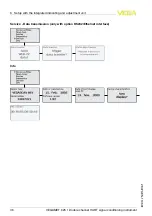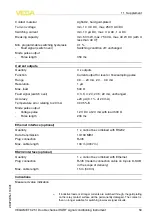
T
he function of the tendency recognition is shown in detail in the
following diagram
.
T
he previously described example is used as a
basis
.
t
t
m
t
m
t
m
t
m
120
180
240
ON
OFF
60
[sec]
1
2
3
4
5
...
...
...
...
100
75
50
25
0
%
...
F
ig
.
15
:
E
xample for tendency recognition
1
O
ld average value
=
25
%
,
new average value
=
25
%
D
i
ff
erence
<
25
%
-
>
R
elay
ON
2
O
ld average value
=
25
%
,
new average value
=
37
.
5
%
D
i
ff
erence
<
25
%
-
>
R
elay
ON
3
O
ld average value
=
37
.
5
%
,
new average value
=
62
.
5
%
D
i
ff
erence
=
25
%
-
>
R
elay
OFF
4
O
ld average value
=
62
.
5
%
,
new average value
=
75
%
D
i
ff
erence
<
25
%
-
>
R
elay
ON
5
tm
-
>
max
.
reaction time
8
.
6
F
low measurement
F
or
fl
ow measurement in open
fl
umes
,
a contraction or standardised
fl
ume must be used
.
D
epending on the
fl
ow volume
,
this contraction
generates a certain backwater
.
T
he
fl
ow can be determined from the
height of this backwater
.
T
he
fl
ow volume is outputted by an
appropriate number of pulses on the relay or current output
.
D
epending on the type and version
,
each
fl
ume generates a di
ff
erent
backwater
.
T
he data of the following
fl
umes are available in the
instrument
:
l
P
almer
-
B
owlus
-
F
lume
l
V
enturi
fl
ume
,
trapezoidal weir
,
rectangular weir
l
R
ectangular weir
,
V
-
N
otch
S
et up
T
he con
fi
guration of the
fl
ow measurement loop requires
PACT
ware
with the suitable
DTM
s
.
T
he example refers to a
fl
ow measurement
with a radar sensor
.
T
he following setup steps must be carried out
:
l
S
election of the parameter
"
F
low
"
l
C
arrying out adjustment
l
S
elect
fl
ume
(
linearization
)
l
S
et scaling
l
P
arameter adjustment of pulse outputs
F
unctional principle
F
lume
50
VEGAMET
625
•
D
ouble channel
HART
signal conditioning instrument
8
A
pplication examples
28970
-
EN
-
110801
















































